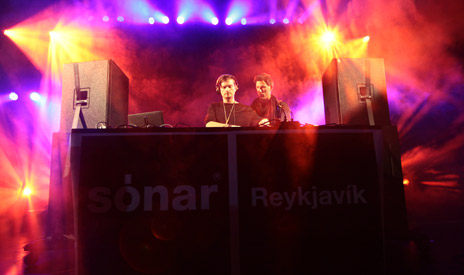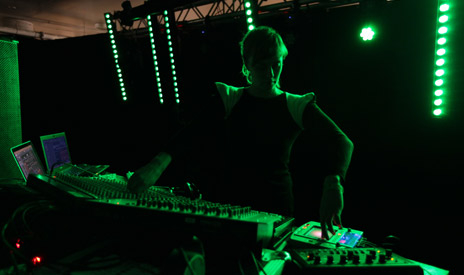- Reykjavik is a small city, with just a few hundred thousand people residing in an area approximately one-twentieth the size of Paris. The Icelandic capital is the famed hometown of Björk, Sigur Rós, Gus Gus and other world-renowned groups, though electronic music has yet to gain a real foothold there. House and techno are generally confined to multi-purpose spaces and cafés, as there are no venues used solely as nightclubs. This made Sonar's Icelandic debut something of a milestone, as it brought an unprecedented influx of international electronic acts, from experimentalists like Alva Noto and Byetone to more accessible artists like Tale of Us and John Talabot.
Sonar Reykjavik took place at Harpa, a harbourside complex that's played host to everything from the annual Iceland Airwaves festival to the Berlin Philharmonic Orchestra since it opened in 2011. Over two nights, close to 50 acts would appear on four stages, two of them dedicated concert spaces, one a hall-like area on Harpa's ground floor, and one a customized area of a basement carpark.
Though much of the space worked very well, many acts fell victim to awkward programming. Visiting DJs were faced with rapidly emptying dance floors as they set up in the moments following a local group's live show, while indie bands were sandwiched between house jocks. It seemed like the goal of showcasing a wide range of music, much of it local, took priority over the flow of the events. This might not be such an issue at rock and indie festivals, but here it felt very significant. Much of Sonar Reykjavik seemed stuck in the middle ground between a club night and an open-air festival, which brought out the undesirable aspects of both forms along with their respective advantages.
 Photo credit: Guillermo Granell
It's no real surprise, then, that the most successful acts weren't DJs, but bands. Local five-piece Sísý Ey were an early highlight, belting out vocal house to one of the biggest crowds of the night. Thugfucker, stone-faced and hunched over a shared laptop, had little to offer the hundreds leaving as Sísý Ey disappeared off stage. The same went for John Talabot on the following night, who looked exceptionally small between two giant speaker stacks in a room that had already hosted Gluteus Maximus, a local duo who had several thousand Icelanders eating out of the palm of their hands as they moved though their repertoire of maximalist techno, complete with weightlifters mingling on stage.
Photo credit: Guillermo Granell
It's no real surprise, then, that the most successful acts weren't DJs, but bands. Local five-piece Sísý Ey were an early highlight, belting out vocal house to one of the biggest crowds of the night. Thugfucker, stone-faced and hunched over a shared laptop, had little to offer the hundreds leaving as Sísý Ey disappeared off stage. The same went for John Talabot on the following night, who looked exceptionally small between two giant speaker stacks in a room that had already hosted Gluteus Maximus, a local duo who had several thousand Icelanders eating out of the palm of their hands as they moved though their repertoire of maximalist techno, complete with weightlifters mingling on stage.
 Photo credit: Guillermo Granell
The place best-suited to club music was the car park, though the quality of those manning the decks in this dark and hard-to-get-to space varied immensely. Highlights were Dasha Rush's elegant techno and Axel Boman's jovial house. Sets from some of the locals weren't quite as ambitious as one would've hoped, with many sticking to tired strands of dubstep and tech house. These performances were a reminder that exposure to outside talent is, in most cases, necessary in the development of any growing dance music community. Reykjavik has no trouble finding folk and indie groups to export the world—this weekend further proved they're in no short supply—but it seems that Iceland is someway short of becoming a breeding ground for house and techno. However, with Sonar Reykjavik set to return for the next few years, a vehicle for change may already be in place.
Photo credit: Guillermo Granell
The place best-suited to club music was the car park, though the quality of those manning the decks in this dark and hard-to-get-to space varied immensely. Highlights were Dasha Rush's elegant techno and Axel Boman's jovial house. Sets from some of the locals weren't quite as ambitious as one would've hoped, with many sticking to tired strands of dubstep and tech house. These performances were a reminder that exposure to outside talent is, in most cases, necessary in the development of any growing dance music community. Reykjavik has no trouble finding folk and indie groups to export the world—this weekend further proved they're in no short supply—but it seems that Iceland is someway short of becoming a breeding ground for house and techno. However, with Sonar Reykjavik set to return for the next few years, a vehicle for change may already be in place.
 Photo credit: Guillermo Granell
It's no real surprise, then, that the most successful acts weren't DJs, but bands. Local five-piece Sísý Ey were an early highlight, belting out vocal house to one of the biggest crowds of the night. Thugfucker, stone-faced and hunched over a shared laptop, had little to offer the hundreds leaving as Sísý Ey disappeared off stage. The same went for John Talabot on the following night, who looked exceptionally small between two giant speaker stacks in a room that had already hosted Gluteus Maximus, a local duo who had several thousand Icelanders eating out of the palm of their hands as they moved though their repertoire of maximalist techno, complete with weightlifters mingling on stage.
Photo credit: Guillermo Granell
It's no real surprise, then, that the most successful acts weren't DJs, but bands. Local five-piece Sísý Ey were an early highlight, belting out vocal house to one of the biggest crowds of the night. Thugfucker, stone-faced and hunched over a shared laptop, had little to offer the hundreds leaving as Sísý Ey disappeared off stage. The same went for John Talabot on the following night, who looked exceptionally small between two giant speaker stacks in a room that had already hosted Gluteus Maximus, a local duo who had several thousand Icelanders eating out of the palm of their hands as they moved though their repertoire of maximalist techno, complete with weightlifters mingling on stage.
 Photo credit: Guillermo Granell
The place best-suited to club music was the car park, though the quality of those manning the decks in this dark and hard-to-get-to space varied immensely. Highlights were Dasha Rush's elegant techno and Axel Boman's jovial house. Sets from some of the locals weren't quite as ambitious as one would've hoped, with many sticking to tired strands of dubstep and tech house. These performances were a reminder that exposure to outside talent is, in most cases, necessary in the development of any growing dance music community. Reykjavik has no trouble finding folk and indie groups to export the world—this weekend further proved they're in no short supply—but it seems that Iceland is someway short of becoming a breeding ground for house and techno. However, with Sonar Reykjavik set to return for the next few years, a vehicle for change may already be in place.
Photo credit: Guillermo Granell
The place best-suited to club music was the car park, though the quality of those manning the decks in this dark and hard-to-get-to space varied immensely. Highlights were Dasha Rush's elegant techno and Axel Boman's jovial house. Sets from some of the locals weren't quite as ambitious as one would've hoped, with many sticking to tired strands of dubstep and tech house. These performances were a reminder that exposure to outside talent is, in most cases, necessary in the development of any growing dance music community. Reykjavik has no trouble finding folk and indie groups to export the world—this weekend further proved they're in no short supply—but it seems that Iceland is someway short of becoming a breeding ground for house and techno. However, with Sonar Reykjavik set to return for the next few years, a vehicle for change may already be in place.